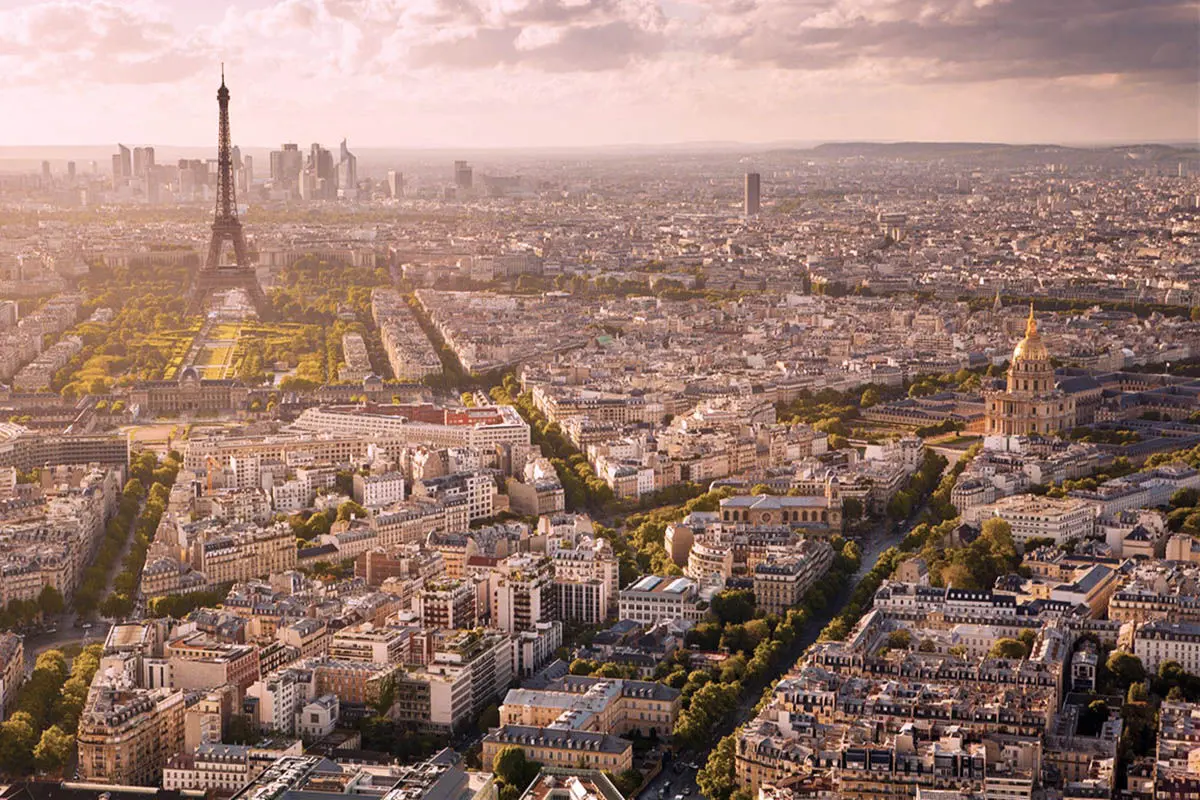
THE CATHEDRAL OF NOTRE DAME
Our audioguide (audioguides) of Paris starts at the Cathedral of Notre Dame. This site has been occupied by different religious buildings since the Roman era. First, there was a temple dedicated to Jupiter, then an early medieval church in the 6th century called Saint-Etienne, and later a Romanesque church.
The structure we can see today was dedicated to the Virgin Mary and was built between 1163 and 1245 in a Gothic style. It has been renovated several times during its 800-year history, the most significant of which was undertaken in the 19th century to repair damage from the French Revolution.
Its famous gargoyles have been rebuilt. Furthmore, various parts of the structure such as the steeple of the dome have been restored, which features a bronze rooster adorned with three relics sitting on a cross. At 93 meters high, it serves as a kind of spiritual lightning rod that protects the faithful of Notre Dame during thunderstorms.
One of the many strange legends surrounding the building tells of a young tradesman who was entrusted with constructing one of the doors. Foolishly, he made a pact with the devil who agreed to help build the door in exchange for his soul. The next day, a beautiful door miraculously appeared, and the builder was promptly promoted from apprentice to master. However, the devil relentlessly tormented him, and he was found dead in mysterious circumstances just a few days later.
The cathedral features two 69-meter towers. Within them, you can see huge bells and mythical gargoyles, the latter of which serves to drain water from the roof during heavy rains.
Another grizzly Notre Dame legend says that when Joan of Arc was burned at the stake, the gargoyles awoke and wreaked havoc on Paris to avenge the heroine’s death. The next day, dozens of corpses were found throughout the streets, which were later identified as those who had witnessed the execution but made no attempt to help.
Its interior is characterized by colorful rose and stain glass windows, the arches of the dome, tall columns, and the crypt, whose ruins were discovered during excavation work in 1965.
The Cathedral of Notre Dame has been the scene of numerous great novels and significant historical events. Victor Hugo’s famous book tells of the Hunchback of Notre-Dame who lives in the bell tower of the cathedral. Furthermore, the coronation of Napoleon Bonaparte and the beatification of Joan of Arc were both held within these walls.
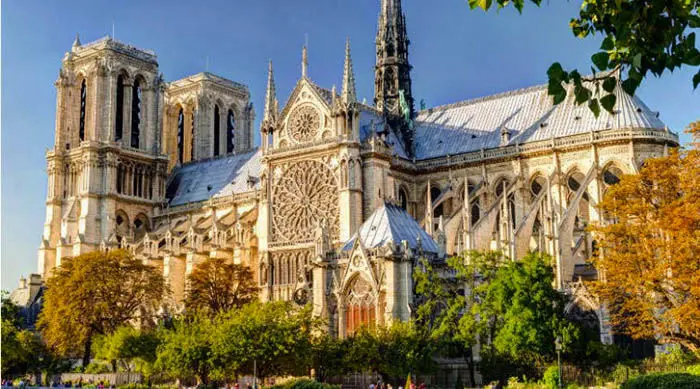
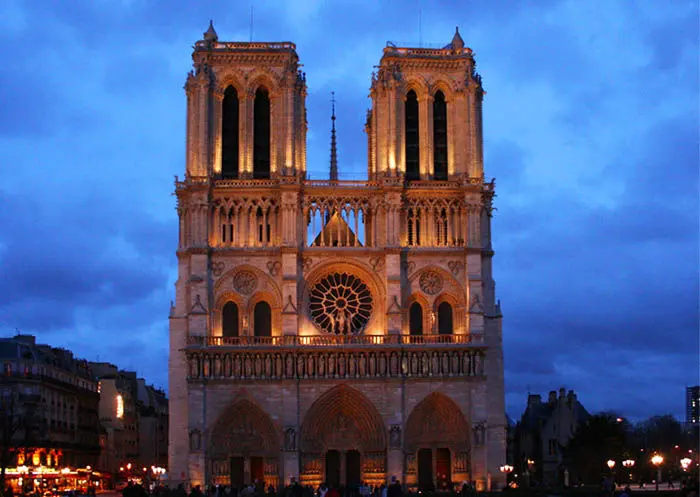
NOTE: THE FIRE OF THE NOTRE DAME CATHEDRAL WILL BE NARRATED AT THE END OF THIS AUDIOGUIDE (AUDIOGUIDES)
THE LOUVRE MUSEUM
This world famous museum is located in an old 12th-century fortification that would later become the royal residence. The building was converted into a museum when the French monarchy moved to the Palace of Versailles.
In 1793, the Louvre opened its doors to the public to showcase the collections of the French monarchy. Over time, the exhibition grew substantially due to military seizures and private donations. It currently contains around 445,000 pieces, of which 35,000 are on display with the audioguide (audioguides).
In 1989, the iconic glass pyramid was built, which still serves as the primary public access point today.
The museum is divided into thematic sections. Among its most famous works are:
La Gioconda (AKA Mona Lisa) by Leonardo da Vinci, Liberty Leading the People by Delacroix, the Wedding Feast at Cana by Veronese, the Venus de Milo from Ancient Greece, the Seated Scribe from Ancient Egypt, and the Winged Victory of Samothrace from the Hellenistic period.
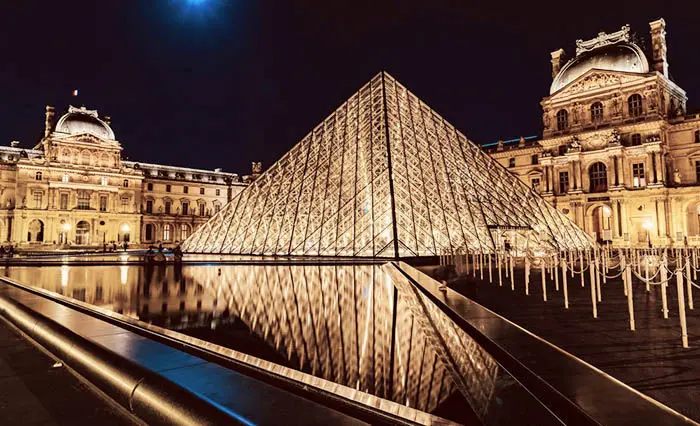
SAINTE CHAPELLE
King Louis IX ordered the construction of this Gothic church in 1242. The monarch had recently bought the Sacred Relics from the emperors of Constantinople, and this new edifice was where they would be held.
The Sacred Relics include the Passion of Christ, the Crown of Thorns, and a piece of the Holy Cross as an iron spear. The king acquired as many as 10 elements related to the martyrdom of Jesus Christ, the acquisition of which made Paris the second capital of Christianity.
The standout feature of this building are the stained glass windows of the upper chapel, which survived the French Revolution because they were protected by large filing cabinets. These 15 dazzling windows flood the chapel with light and color while portraying scenes of the history of humanity, from Genesis to the Resurrection of Christ.
The relics that survived the French Revolution are currently held in the Cathedral of Notre Dame, whose audioguide (audioguides) is also available.
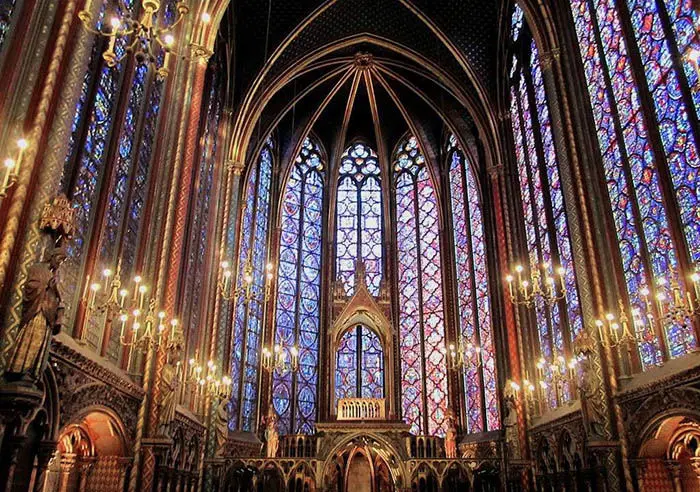
THE FRENCH REVOLUTION
The French Revolution was one of the most important events in French history, effectively marking the end of the Modern Age and the beginning of the Contemporary Age.
It began on July 14, 1789, the day the common classes seized the Bastille, an ancient fortress and prison that represented the oppression of the Old Regime.
There are several aspects that motivated the Revolution: the nobility and the high clergy enjoyed unjust privileges and were exempt from paying taxes; the common classes were subject to constant tax hikes due to a financial crisis in the country; and low harvests increased the price of basic consumer goods such as bread and grains. Perhaps the most significant trigger, however, was the emergence of the Age of Enlightenment, which saw the rise of great advocates and promoters of ideas such as equality, reason, and liberty.
Inspired by these events, the commoners overthrew the Bastille. A month later the National Assembly removed the privileges of the nobility and the clergy, forcing them to pay taxes. In 1791, a new French constitution was introduced, enacting the equality of all citizens before French law.
However, the people began to support the radical ideas of the Jacobins to impose the Revolutionary Republic in France and to rid the country of the monarchy.
Finally, they seized the Tuileries Palace and captured the king and his family, which is when heads began to roll. The Jacobins executed clerics, nobles, the bourgeoisie, and the monarchy. In 1793, King Louis XVI was executed by guillotine, a fate later suffered by his wife, Marie Antoinette.
With the death of Louis XVI, the Constitutional Monarchy finally came to an end. What followed was the beginning of a period known as the Reign of Terror, in which the Jacobins, led by Robespierre, used the guillotine indiscriminately.
In 1795, the bourgeoisie retook power and created a revised constitution. This began a new phase of the French Revolution called the Directory, which provoked even more Jacobin revolts.
The end of the French Revolution came in 1799 when Napoleon Bonaparte led a coup by proclaiming himself the emperor of France and extending the ideals of equality, liberty, and fraternity.

THE CONCIERGERIE
This building was the royal residence of the monarchy from the 10th until the 14th century when Charles V left the palace and it was converted into a state prison.
During the French Revolution, it was the antechamber of death. More than 2,700 prisoners were executed after passing through these halls.
One of the best-known prisoners was Marie Antoinette. A highly detailed reconstruction has been made of her cell, from which she tried to flee. After that, they had her locked up inside and watched over by guards before eventually decapitating her in the Place de Concorde. Louis XVIII later ordered her original cell to be converted into a chapel.
Other well-known prisoners included Antoine Lavoisier, Francisco de Miranda, and Maximilien Robespierre.
The Conciergerie functioned as a prison until 1914, and it can still be visited today. During a tour with the audioguide (audioguides), you can see the conditions which poor and wealthy prisoners faced, as well as the separation of men and women. While some slept on the ground and were inadequately fed, others enjoyed comfortable beds, lavish furniture, and sometimes even servants.
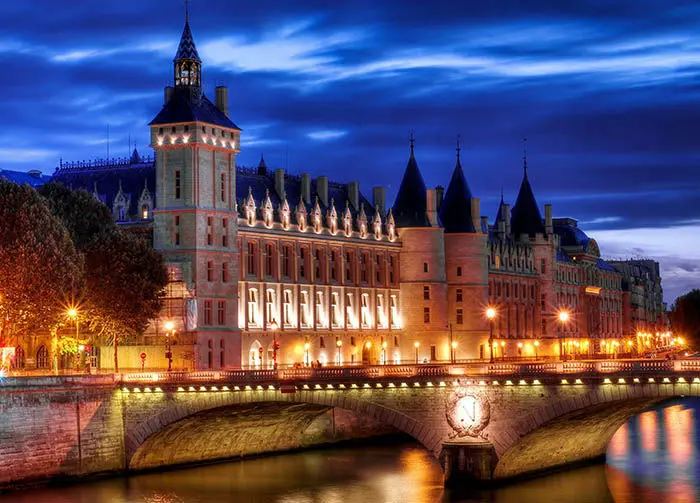
THE EIFFEL TOWER
In the lead up to a grand world fair known as the Universal Exhibition in 1889, the government decided to construct a colossal iron tower in Paris’ Champ de Mars to commemorate the first centenary of the French Revolution.
The official French Bulletin published a contest to find a grand architectural design. Of the 107 proposals submitted, Gustave Eiffel won first place. His iconic masterpiece consists of 18,000 pieces.
Given the difficulty of its construction, a group of experts were called in to participate in the creation of the massive metal viaducts.
The "Protest against the tower of Monsieur Eiffel” was one of the many problems that arose during the project. Big names in the world of art and literature such as Guy de Maupassant, Alexandre Dumas, and François Coppée saw it as a monstrous and useless metal construction that would ruin the city they so dearly loved.
These controversies came to an end once the tower was completed in record time: 2 years, 2 months and 5 days, measuring 125 meters wide and 300 meters high.
The tower was a hit throughout the Universal Exhibition, receiving over 2 million visitors. However, Parisians would lose interest in the years to come, prompting them to consider demolishing it.
To avoid this from happening, Gustave Eiffel fought to give the tower a scientific use. It served for a time as an observatory, a radio antenna and, later, as a television antenna. In fact, during the First and Second World War, numerous messages were emitted and intercepted through the tower by both sides.
One subsequent well-known event was when the famous tailor, Franz Reichelt, created a parachute based on the design of Leonardo da Vinci and decided to test it by launching himself from the top of the tower in front of a large audience. Unfortunately, the contraption didn’t work as planned and Reichelt plummeted to his death.
At the foot of the Eiffel Tower is the next audio of the audioguide (audioguides).

CHAMP DE MARS
Next stop of this audioguide (audioguides), these are the gardens located at the foot of the Eiffel Tower. Just on the other side is the military school, which was used as an area to perform tactical maneuvers.
The Champ de Mars was initially used to cultivate vegetables. After the construction of the aforementioned military school, it was named in honor of Mars, the Roman god of war.
This grand esplanade has hosted universal exhibitions and revolutionary festivals. One famous example is the Feast of the Federation. On July 14 each year, the capture of the Bastille, which marks the beginning of the French Revolution, is celebrated in style.
During the French Revolution, a huge mass of people gathered at the Champ de Mars to push for France to become a republic and for the monarchy to be removed. The protest ended with 50 dead and hundreds wounded.
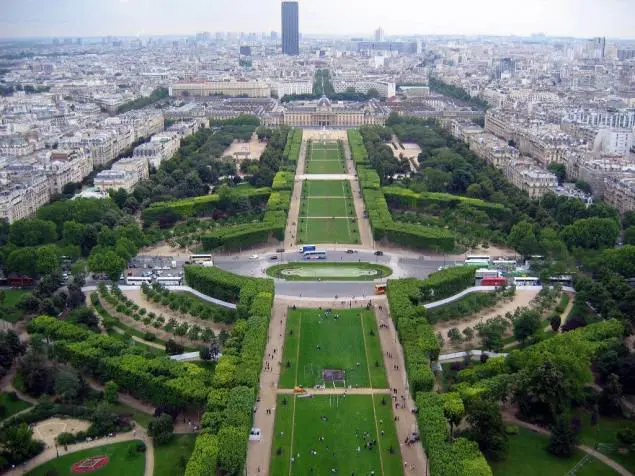
HOTEL DES INVALIDES
Out of concern for the war heroes who had been left homeless, King Louis XIV had this complex built in the 17th century to serve as a veterans home.
The first guests arrived in 1674 and numbered around 4,000 by the end of the century.
Within the complex, King Luis XIV ordered the construction of two similar yet separate churches: the Cathedral of Saint-Louis des Invalides, which is considered the church of the French armed forces; and the Dôme des Invalides, which is named after its great golden dome and would be used for worship by royalty.
In 1840, the Dôme des Invalides became a mausoleum to house the remains of Napoleon Bonaparte. His body was transferred to Paris from the island of Saint Helena, where he died while in exile. The ashes were placed in a sarcophagus surrounded by a circular gallery which is decorated with reliefs and statues that portray his most important battles.
Here also lie the remains of Napoleón’s son, his brother José I of Spain, and several marshals, among them Lyautey, Foch, and Leclerc.
The complex houses a hospital which once treated the most severe injuries; with the audioguide (audioguides) you can also visit the Navy Museum, the Artillery Museum, and the Museum of Contemporary History.
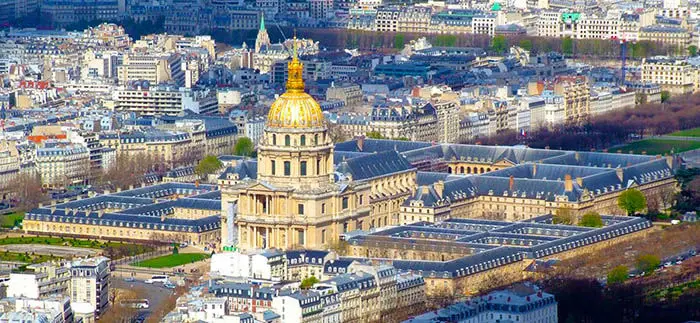
THE PANTHEÓN
The Pantheon of Paris was built in the late 18th century to simultaneously demonstrate the simplicity of Gothic and the grandeur of Greek architecture.
Originally, it was to be a church dedicated to Santa Genoveva, the city’s patron saint. However, with the arrival of the Third Republic, it was decided to use the building as a mausoleum which would house the remains of illustrious French figures. Thus, in its crypt, we can find with the audioguide (audioguides) the tombs of Voltaire, Rousseau, Victor Hugo, Marie Curie, Louis Braille, Jean Monnet, and Alexandre Dumas.
The names of those who died during the revolutions of 1830 and 1848 are written on the walls, along with the French writers who perished during the First and Second World Wars.
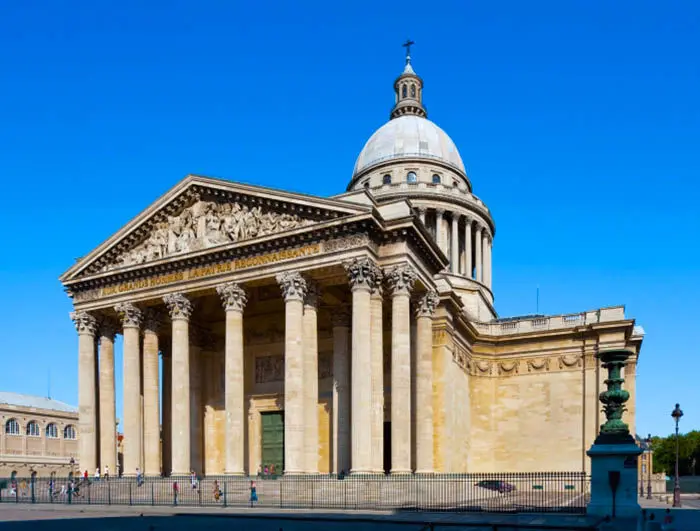
THE CATACOMBS OF PARIS
The catacombs are a system of underground tunnels that span over 300 kilometers and house more than 6 million human remains from different eras.
At first, these tunnels were limestone quarries known as Les Carrières de Paris which were used to build many of the monuments that we can see in the city today.
Later, their use would radically evolve. In 1786, the corpses and bones were moved from various regional cemeteries to the tunnels because the diseases that were ravaging Paris were becoming increasingly widespread.
It took around 15 months to move the millions of bones, all of which was done during the night to maintain absolute discretion.
Only a small section of the tunnels is open to the public and is visitable with the audioguide (audioguides).
During the Second World War, both sides used the tunnels for their own benefit, and a bunker was even built in one of the underground areas.
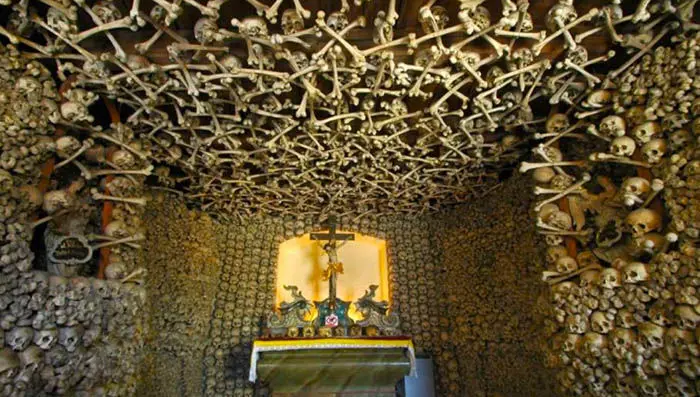
ARC DE TRIOMPHE
An ode to the French victories under the command of Napoleon, the Arc de Triomphe is the next stop of the audioguide (audioguides) and one of the city’s most symbolic monuments. In fact, it was Napoleon who ordered its construction after the battle of Austerlitz in 1806. The arc took 30 years to erect. Therefore, Napoleon, who died in 1821, never got to see the final construction. Upon being repatriated from Santa Elena, his remains passed under the arch on their way to Les Invalides.
The names of Napoleon’s victorious battles along with the 558 French generals who assisted him have been inscribed across its four pillars. Some are underlined, which indicates that the general died in combat.
At the base of the 50-meter high monument is the Tomb of the Unknown Soldier. Alongside it is the Eternal Flame which burns in the memory of the million and a half unidentified soldiers who died during World War I.
A few weeks after the end of the war, Charles Godefroy flew his plane across the arch to honor all the aviators who were killed at war.
After each victorious battle, the French soldiers would march under the arch in celebration. In contrast, after the Nazis occupied Paris, the Germans crossed through the arch to celebrate their own victory.
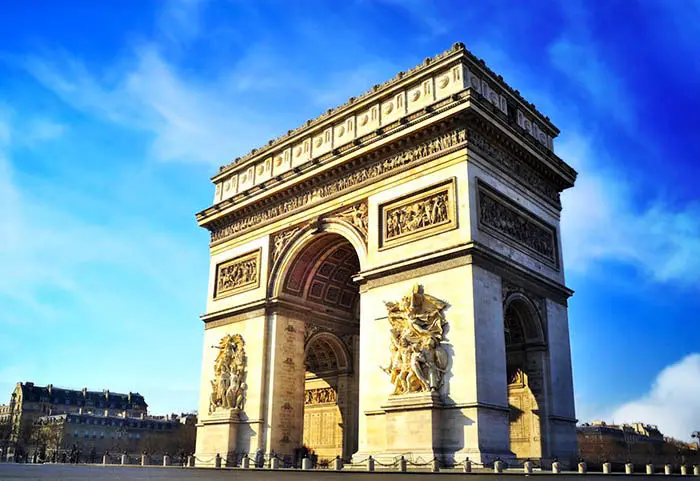
CHAMPS ELYSEES
Connecting the Arc de Triomphe with the Place de Concorde, the 2-km long Champs Elysees is one of the most famous avenues in the world. Every year the Tour de France ends here.
Its name comes from Greek mythology and refers to where good people go when they die, somewhat similar to the Christian concept of heaven.
All along the street you can find shops, restaurants, and cinemas, which make it a pleasant spot for both Parisians and tourists to stroll with the audioguide (audioguides).
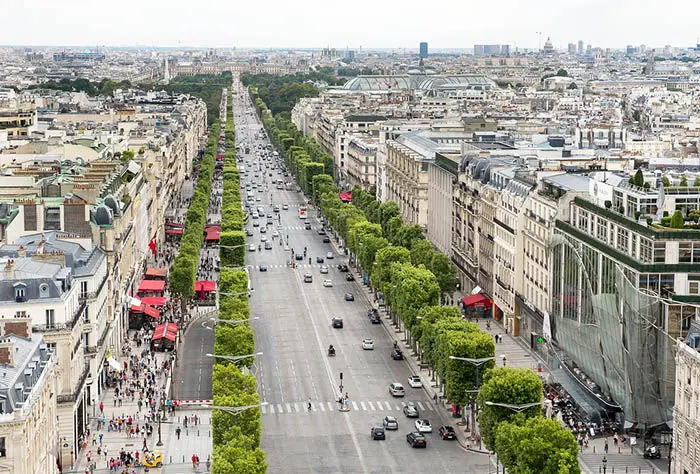
TUILERIES GARDEN
After the death of her beloved husband King Henry II of France, Catherine de Medici ordered the construction of a grand palace in 1564. The grounds feature extensive gardens in the Florentine style, which reminded Catherine of her hometown and aristocrat family.
The name of Tuileries refers to the "tuiles" or tile factories that occupied the space before the construction of the palace.
At that time, parties were held in the gardens for Paris’ high society, which were completely hidden from the public by the walls surrounding the gardens.
These gardens consisted of sparse grassy areas, groves, orchards, fountains, caves, a menagerie, and a large collection of statues which have survived to this day.
Since Catherine de Medici passed away, the palace has been inhabited by numerous French monarchs, from her son Henry IV up until Napoleon III.
After the capture of Napoleon III in the Franco-Prussian war, a radical socialist and revolutionary government known as the Paris Commune formed to oppose imperialism. Although it did not last long, many reforms were promoted during these months of resistance, which would later serve as a textbook example for other revolutionaries elsewhere in the world.
On May 23, 1871, Jules Bergeret, the commander of the detachment of the Commune, ordered the Tuileries Palace to be burned to the ground because it represented the power of the French government which the Commune did not recognize. The fire lasted 48 hours and swept through the palace in its entirety. Only the gardens you can see with the audioguide (audioguides) could be saved.
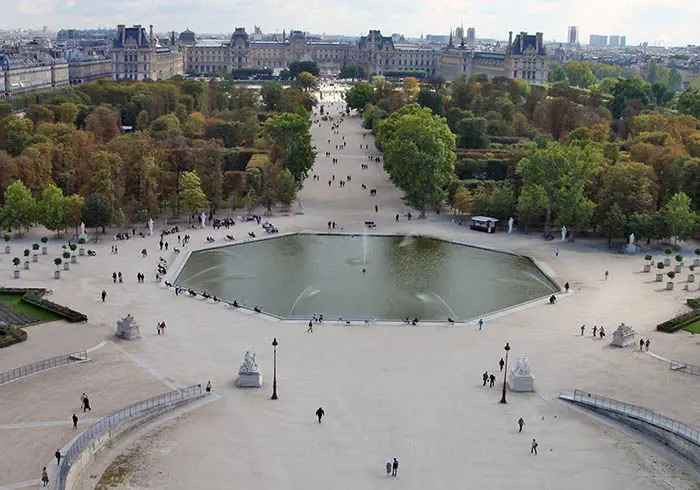
PALAIS GARNIER
In the mid-19th century, Napoleon III ordered the construction of a new building to serve as an opera house. The king held an architectural design contest which received more than 170 proposals. The 35-year-old architect Charles Garnier won first prize.
On the outside, the facade is decorated with allegorical sculptures of Harmony, Music, Apollo, Poetry, Drama, Dance, and Opera. Going inside with the audioguide (audioguides) we can find a grand central staircase and a massive stage, which was the largest in the world at the time, measuring 49 meters wide and 26 meters deep.
During the construction, Napoleón III ordered an avenue to be built to unite the Palais Garnier with the Palace of Tuileries. This displaced many families and ultimately left them homeless, causing outrage among local residents.
There were rumors of the project being abandoned when the Second French Empire fell in 1870. This occurred after the capture of Emperor Napoleon III at the Battle of Sedan during the Franco-Prussian War.
Eventually, the decision was made to continue with construction because the old Paris Opera House, known as the Royal Academy of Music Theatre, was destroyed in a fire.
In 1875, its grand inauguration was held. However, the Opera House’s architect, Charles Garnier, was notably absent from the guest list.
Due to his close friendship with Napoleón III, the new government of the Third Republic decided to exclude him from the festivities.
Thus, the Phantom of the Opera, the famous work of Gaston Leroux, was inspired by the opening ceremony of the Garnier Opera House.
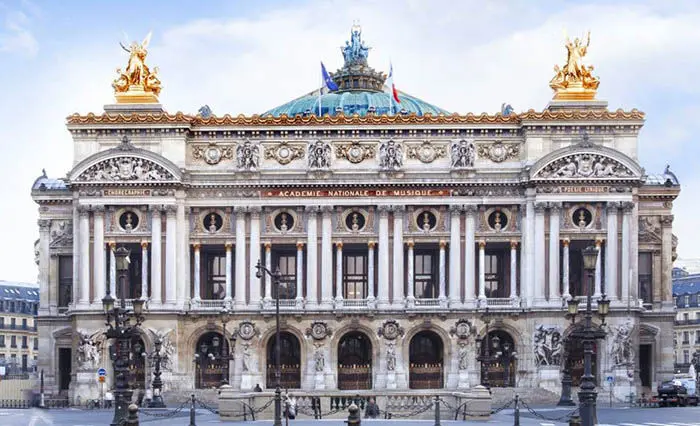
THE BASILICA OF THE SACRED HEART
This basilica was built to honor the 58,000 people who lost their lives in the Franco-Prussian War.
Construction began in 1875 and took 39 years to complete. A unique stone called travertine was used, which manages to retain its impeccable white color despite the adverse effects of weather and pollution.
Just above the entrance, we find a statue of Jesus with a Latin inscription: "Cor Jesus Sacratissimum," which translates to "the Sacred Heart of Jesus."
Interior highlights include the Cavaillé-Coll Organ, the Apse Mosaic, which is considered one of the largest mosaics in the world dedicated to Christ, and the crypt, which is divided into three chapels in honor of La Pieta, Saint Peter, and the Holy Family.
Climbing the 237 steps with the audioguide (audioguides) to the top of the 83-meter basilica roof provides an excellent viewpoint of the city.

THE PALACE OF VERSAILLES
During the reign of Louis XIII, the current site of the Palace of Versailles was a vast hunting ground with a more modest edifice where the monarch would sleep. The ostentation for which Versailles is known would come much later.
In 1682, Louis XIV decided to move the court to his father’s old hunting lodge, thus making Versailles the center of government.
Year after year, the palace and its gardens were renovated and expanded upon, serving as the royal residence until the reign of Louis XVI.
Highlights of the 2,300 room palace include the Royal Chapel, the King and Queen’s Grand Apartments, and the Hall of Mirrors, a 73-meter room which contains 375 mirrors. This was the spot where the First World War ended through the signing of the Treaty of Versailles.
The decoration of each room has been undertaken with great care, featuring the works of the best French and Italian artists of the time. Furniture, sculptures, tapestries, and historical paintings, some of which have since been moved to the Louvre Museum, adorned the walls throughout the compound.
Within its 800 hectares of lush gardens, we can find with the audioguide (audioguides) a diverse array of plants and trees, as well as statues, ponds, fountains, and buildings. Highlights include the Grand Trianon, a small pink marble palace where Napoleon once resided, and the Domain of Marie Antoinette, the place where Louis XVI’s wife was isolated from the court to lead a more simple life.
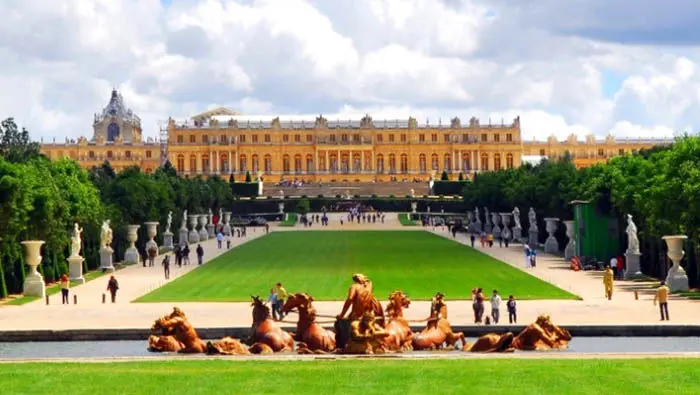
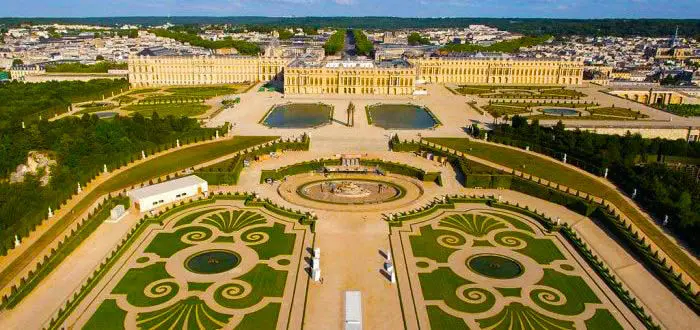
LUXEMBURG PALACE AND GARDENS
This palace was originally a hotel owned by Duke François du Luxembourg, who bestowed it his name. When Enrique IV was murdered, his wife, María de Medici, decided to leave the court and settle here. In 1615, the hotel began its transformation towards a palace featuring lush gardens of the purest French style.
Through the annexation of the surrounding land, including a convent of Carthusian monks, the gardens grew to eventually cover a sizable 22-hectare lot.
The palace was decorated with paintings brought in from the Louvre and frescoes by Delacroix. Its ostentatious appearance would remain until the French Revolution broke out, upon when it was converted into a prison. During the Second World War, the Nazis used it as an air force headquarters and built a bunker in the garden.
Nowadays, Parisians and tourists alike use it as a recreational ground. People come to sunbathe on the lawn with the audioguide (audioguides), play tennis, ride the merry-go-round, study arboriculture or beekeeping, and sail miniature boats in the lagoon.
In addition, the Luxembourg Palace has been the seat of the French Senate since the 1960s.
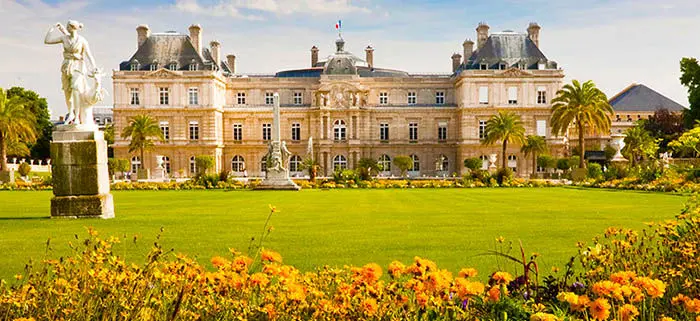
MUSEE D’ORSAY
Next interesting place of the audioguide (audioguides), the museum is located in the old Orsay train station and was inaugurated in 1900 on the occasion of the World Exhibition in Paris.
The space was abandoned after the Second World War and the French state wanted to demolish it. In 1977, a successful bid was made to build a museum in the train station to house 19th-century works.
In the Musée d'Orsay collection, we can enjoy impressionist and post-impressionist paintings, as well as sculptures, decorative arts, photographs, and architectural elements. The most prestigious artworks come from Renoir, Cézanne, Gauguin, Monet, Van Gogh, and Seurat.
The glass and steel dome that covers the central room retains the station's old-world charm and illuminates the entire room with natural light.
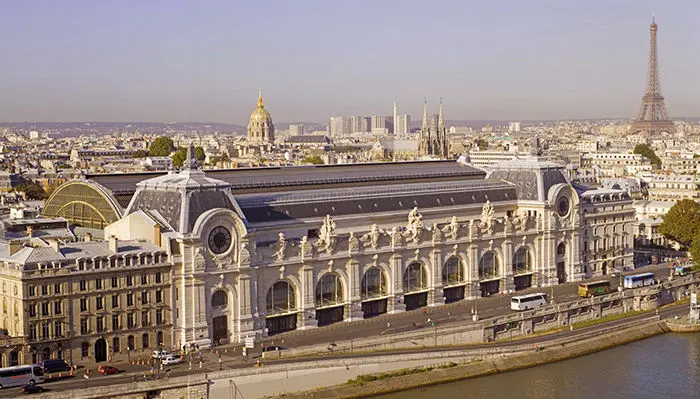
PLACE OF CONCORDE
Built in 1757 under the name of Place de Luis XV, you are now standing with the audioguide (audioguides) in the second largest square in all of France. To commemorate the king’s recovery from a serious illness, the square was not only given his name, but a grandiose equestrian statue was erected in the middle as well.
The square was the scene of more than 1,200 beheadings during the French Revolution, in which a guillotine was used to execute those against the revolution. Some of the more well-known victims include King Louis XVI, Queen Marie Antoinette, Robespierre, Princess Isabel of France, and Madame du Barry.
In 1792, Luis XV’s equestrian statue was demolished, and the square was renamed "Place de la Révolution."
When the darkest stage of the revolution, known as the Reign of Terror, ended in 1795, the decision was made to change the name of the square again as a symbol of reconciliation. It has since been known as the Place de Concorde.
In the middle of the square currently lies a 280-ton Egyptian obelisk which stretches 23 meters high and is adorned with hieroglyphs that celebrate the kingdom of Pharaoh Ramses II. The Egyptian government gifted the obelisk to France in the 19th century.
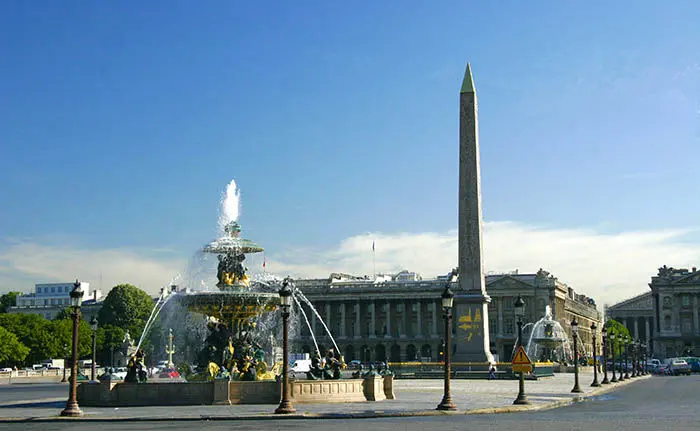
PONT DE L'ALMA
Since the 19th century, locals have been using a statue of a soldier below the bridge to assess the water level of the Seine River during times of flooding. Access to the footpaths on the riverbanks is restricted when the water reaches its feet. The river is no longer navigable by boat when the water reaches its thighs.
After months of rain, the Seine River flooded Paris and its subway tunnels in January 1910, forcing thousands of Parisians to be evacuated from their homes by boat. At that time, the water reached the shoulders of the statue, a full six meters above the normal level. Temporary wooden footbridges had to be built just to move people around the city during the flooding which lasted for 35 days.
From this bridge, you can see with the audioguide (audioguides) the tunnel where Princess Diana of Wales lost her life. At the top is the Flame of Liberty, a life-size replica of the torch held by the Statue of Liberty in New York. It dates from 1989, which coincides with the 100th anniversary of the first English newspaper to be published in Paris. The flame became an unofficial memorial to Princess Diana upon her death in 1997.
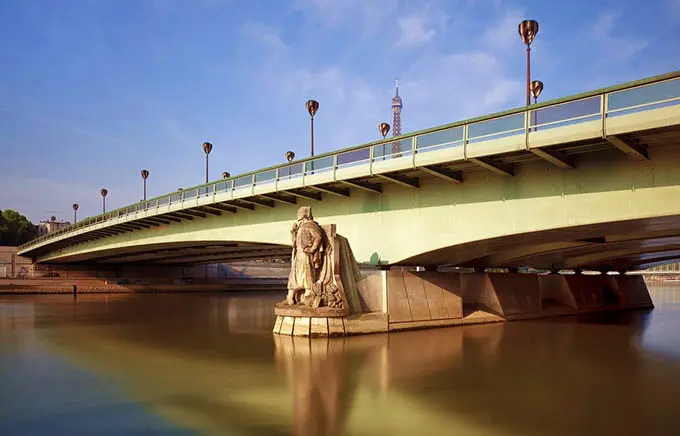
BASILICA CATHEDRAL OF SAINT DENIS
This basilica we can see with the audioguide (audioguides) dates back to the death of Saint Dionysius in the 7th century, who was the first bishop of Paris and patron saint of France. The church houses his tomb and was built over the top of the former cemetery of Saint-Denis.
Since the death of King Hugo Capet in the 10th century, the basilica has been the preferred place to bury the French monarchy.
For this reason, French kings would visit the basilica before leaving for battle to pray and to collect the Oriflamme, a fear-inducing battle flag that symbolized the French abbey of Saint-Denis.
The tombs of the monarchs were defiled during the French Revolution, and their remains ended up in a common grave. In 1817, many of the bones were identified and returned to their corresponding tombs. The remains that could not be identified are kept in the great ossuary which is located in the crypt of the basilica.
Some of the historical characters that rest inside include Luis VIII the Lion, Phillip IV the Fair, Charles V the Wise, Isabel of Bavaria, Ana of Austria, and Marie Antoinette. In total, 42 kings, 32 queens, and 63 princes and princesses have been laid to rest in the basilica.
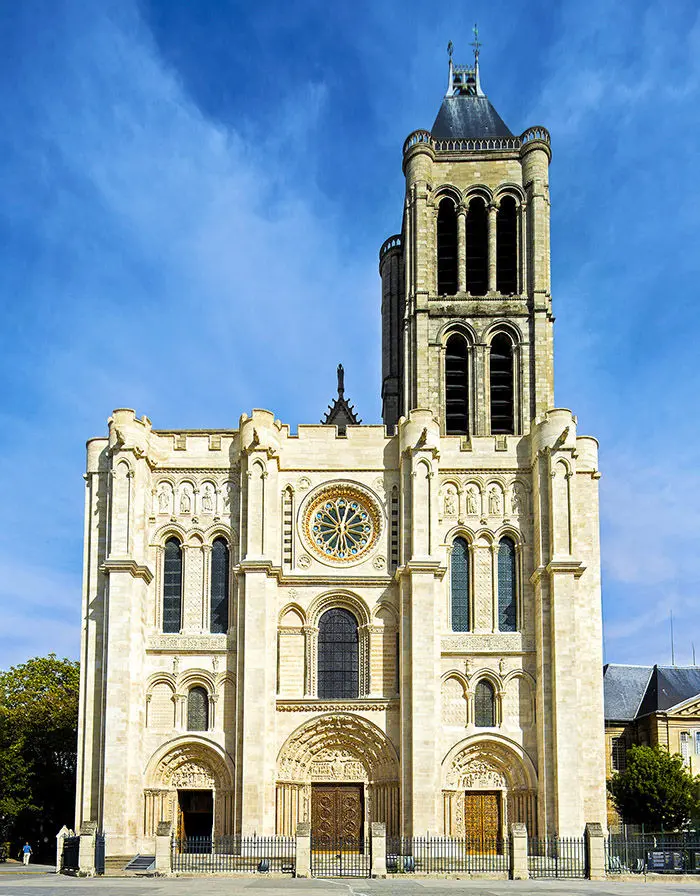
THE TRAGIC DAY THAT PARIS’ NOTRE DAME BURNED DOWN
At 6:20 pm on Monday April 15, a fire alarm flickered in the control centre of Notre Dame Cathedral. A probable computer error led security guards to the wrong section of the building. The cathedral was evacuated cautiously because mass had only just began. It wasn’t until the alarm went off again at 6:45 pm that cathedral security guards first saw the flames which raged more than 3 meters high in the spire of Notre Dame. By the time they reached the fire, it was so out of control there was nothing they could do.
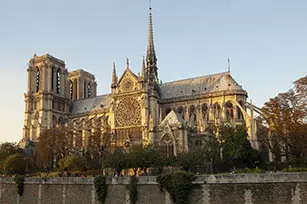
The "forest," as the wooden structure that supported the 13th century ceiling was called, completely burned, while one of the two towers and the interior of the monument suffered significant damage. The 93-meter-high spire collapsed, falling in on itself within the building.
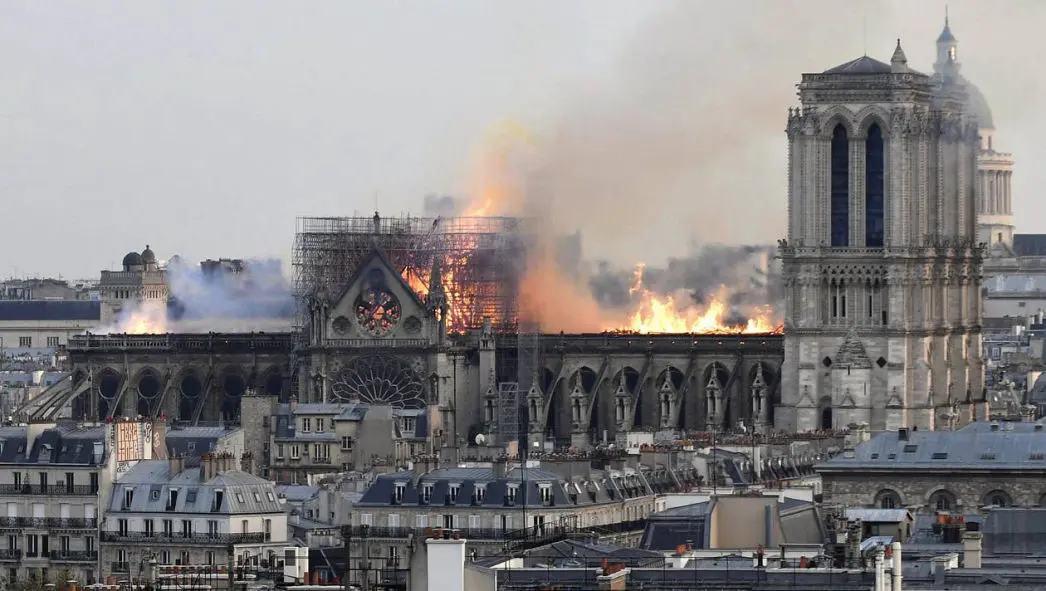
Many stained glass windows were destroyed or badly damaged. Fortunately, the southern rosette was spared.
The rooster that was located on the top of the spire as a spiritual lightning rod to protect Parisians was miraculously found relatively intact among the rubble. It is a historically significant artefact as it contains valuable relics including one of the 70 thorns of the crown of Christ. The altar was also spared from the flames.
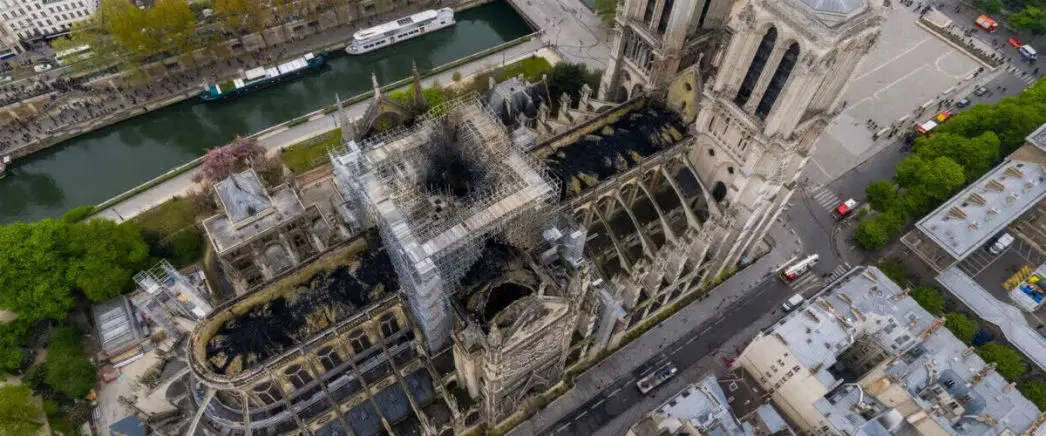
The most precious relics of Notre Dame, the thorn crown of Christ and the robes of St. Louis, were saved by the firemen. It is estimated that 10% of the artworks held in the building were destroyed.
The 15th-century organ suffered some damage. Despite the high temperatures, neither its wooden frame nor the lead and tin pipes had burned. The instrument became unusable due to the dust and water that settled within, so it will be necessary to individually clean and tune each of the 8000 tubes – a monumental task.
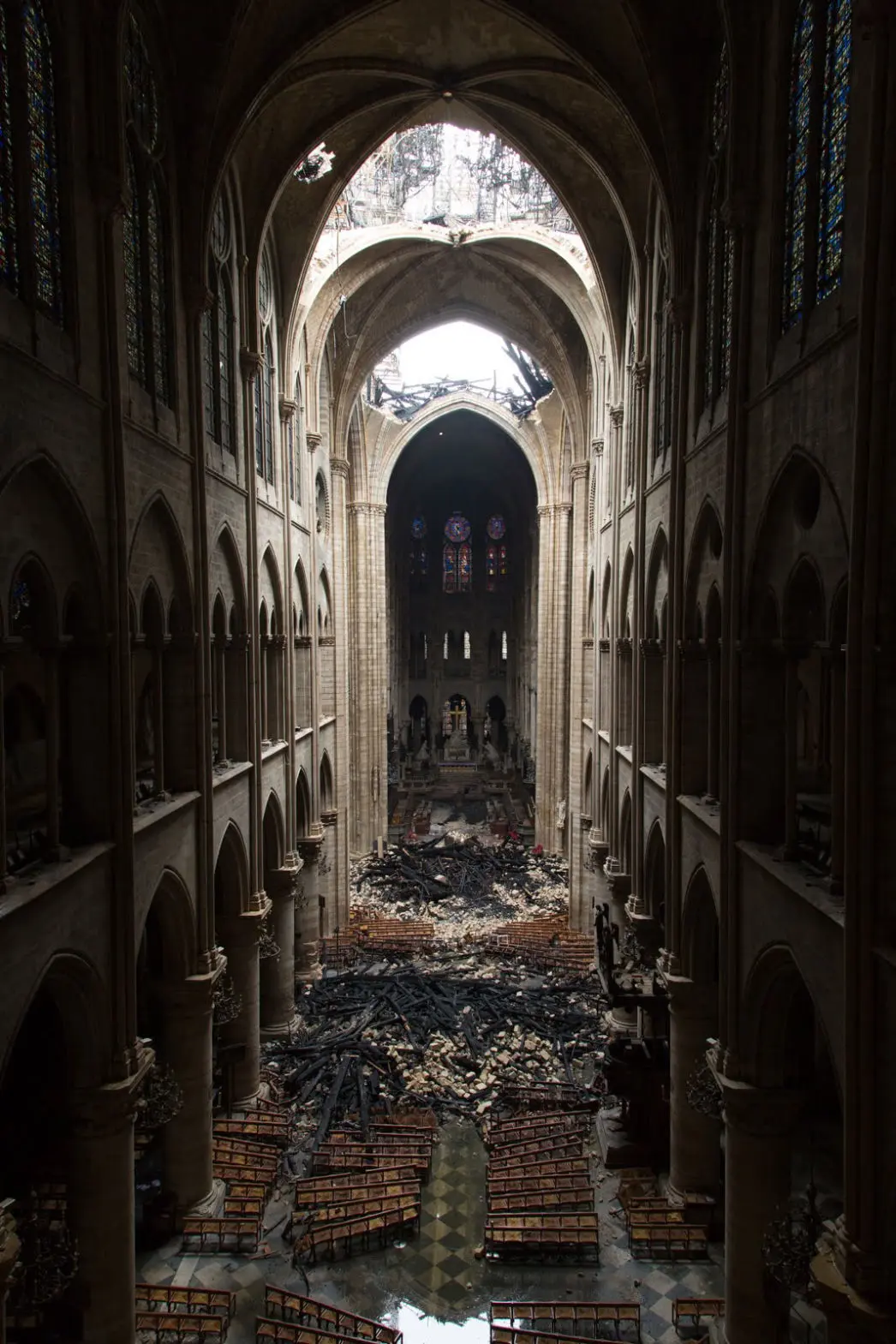
A wave of generosity took place immediately after the fire devastated Notre Dame. Just three days later, the total amount of collected donations had exceeded 900 million euros.
The Paris Mayor and the French President want to do everything they can to ensure Notre Dame is rebuilt as soon as possible. However, according to experts, it is unlikely that the necessary works will be carried out in less than ten years.
The reconstruction of Notre Dame raises a series of questions. France runs the risk of facing a lack of skilled labor such as stone carvers, carpenters, and roofers. Another big question is whether the cathedral should be reconstructed in the same way as it was before, or if it would be more appropriate to replace the wooden sections with steel to prevent future fires.
Audio guide devices, Multimedia audio guides,
Audio guide GPS tourist bus-train, charging bases and accessories.
Group guidance systems, headsets, charging cases, tour guide systems accessories.
Audioguides available from mobile devices, web App, downloadable App from Google Store.
Audioguides in several languages, translations, voiceovers. Audio descriptions, signoguides, visual contents for audioguides. 3D Reality.